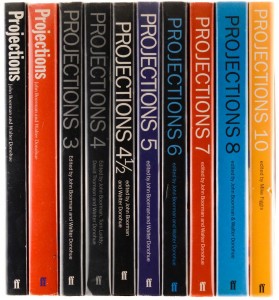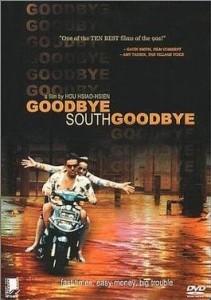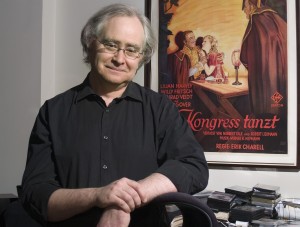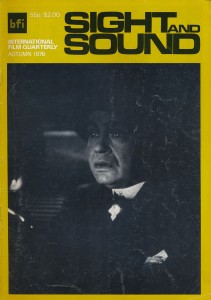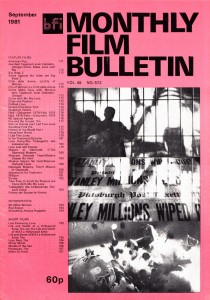From Projections 8, edited by John Boorman and Walter Donohue, 1998. Subtitled Film-makers on Film-makers, this issue of the periodic Faber and Faber publication was devoted specifically to what it called ‘criticism,’ spurred jointly by a brief declaration by Bruce Willis at Cannes in 1997 (‘Nobody up here pays attention to reviews…most of the written word has gone the way of the dinosaur’) and a lengthy essay by François Truffaut, ‘What Do Critics Dream About?’, introducing his 1974 collection The Films of My Life. As nearly as I can remember, I was one of the nine critics (along with Gilbert Adair, Geoff Andrew, Michel Ciment, Peter Cowie, Kenneth Turan, Alexander Walker, Armond White, and Jonathan Romney) asked to respond to these two declarations of principles. (I haven’t been able to find Truffaut’s essay online, but an excerpt from it can be found here: https://www.lostinthemovies.com/2009/04/what-do-critics-dream-about.html.)
If my comments about the Truffaut essay sound harsh, I hasten to add that I still regard his early criticism as seminal — perhaps even the most seminal that was written by Bazin’s younger disciples, as Godard, among others, has suggested. -– J.R.
I welcome the prospect of an issue of Projections devoted to `the art and practice of film criticism’, though given the present climate that circulates around film discourse in general — a climate at once pre-critical and post-critical in which the static produced by commerce tends to drown out most of the murmurs associated with criticism — I’m more than a little fearful about what results such an inquiry is likely to yield. Moreover, the postcritical slant of Truffaut’s troubled 1975 essay — including his stark assertion that ‘No artist ever accepts the critic’s role on a profound level,’ which is simply a more nuanced version of Bruce Willis’s ‘recent outburst’ — already pitches the debate at a fairly alienated level to begin with. For starters, consider the reduced role played by criticism — commentary, let’s say, on ‘the art and practice of film’, as distinct from commerce — in previous issues of Projections, not to mention the reconfigured Sight and Sound after the departure of Penelope Houston (which overlaps with the reconfigured Monthly Film Bulletin, as absorbed by Sight and Sound, after the departure of its own long-term editor, Richard Combs). What we generally find in both publications now is commentary on film in which criticism plays both a subsidiary and an ill-defined, occasional role, a situation that is more or less replicated in such American magazines as Film Comment, which mixes commerce and criticism, and Premiere, which virtually dispenses with criticism altogether. And if we turn to academic film journals on both sides of the Atlantic, I don’t think we find the situation appreciably different or better, because there the notion of commerce generally becomes transposed to academic careers and investments without any substantial increase in independence. Conformity, fashion and institutional license — usually combined with a reluctance to challenge the status quo of what films multicorporations chose to make available and how — still predominate over any sense of an open-ended intellectual forum. The same trend is observable in the British Film Institute’s recent Century of Cinema series of documentaries, a bureaucratic package predicated on the premise that film history needs to be taught by film-makers rather than critics or historians, and that bureaucratic inventions like national cinemas are the best way to divvy up the spoils. (To counter such a premise, I can only recall a heroic transnational anti-bureaucrat like Henri Langlois — or the remark earlier this year of a Chicago-based film critic from Lima that Hou Hsiao-hsien’s Goodbye South, Goodbye, set exclusively in Taiwan, has more say about what’s currently happening in Peru than any Latin American film he’s seen. For surely what’s affecting the planet most at the moment has more to do with the movement of multinational capital than the issue of national differences.)
In so far as all critics today, willingly or not, are children of the New Wave and the explosion in film consciousness that it fostered, Truffaut has to be considered one of the godfathers — but only in concert with his original comrades in arms, an unruly clan including not only Godard, Rohmer, and Chabrol, but also Rivette, Moullet, and Straub. And none of them, I wager, would adhere to all the propositions of Truffaut’s essay, which assumes an essential rift between artistic and critical practice that perhaps only Rohmer and Chabrol would share. For the others, over the past four decades, the act of filming has never been totally separate from the practice of film criticism. Indeed, what is the legacy of the New Wave if not this central perception?
By virtually equating film criticism with newspaper and magazine reviews and implicitly assuming that contemporary consumer advice represents the sum of its aspirations, Truffaut does the profession as a whole, including his own important contributions to it, a gross disservice. At the same time, I feel obliged to acknowledge that twenty-two years ago, these assumptions were probably less sinister than they seem today. Back then, towards the end of the New Wave’s cultural triumph, it was easier for a North American or West European to feel confident that most of the important films would turn up in theatres: not everything and not immediately, but enough of the major works to make reviews a reasonable index of was happening and what mattered in cinema. Today that’s no longer possible. With the near-demise of independent exhibition (perpetuated in the US by the non-enforcement of anti-trust laws), the astronomical growth of film advertising (including unpaid advertising) in all of the media and the concomitant corruption of most reviewing into simple promotion, the crumbling of state support for film culture (apart from the multicorporate product that needs it the least), maintaining a position such as Truffaut’s today borders on the obscene.
I don’t wish to deny, however, that this position is indeed prevalent at moment, which is what makes Truffaut’s essay so prescient. According to this position, ‘success’ as a film critic means in effect being reduced to silence, if one considers the ‘progress’ of some of the best American reviewers — Dave Kehr, my predecessor on the Chicago Reader, moving from that alternative weekly to the Chicago Tribune, then to the New York Daily News, or John Powers, moving from the LA Weekly to Vogue: in both cases, an increase in readership and salary corresponding to a loss of space and choice in what to write about. On this level of achievement, the ultimate power is to get reduced to sound-bites as a TV reviewer grading the weekly releases. But what does that power ultimately amount to? What sort of influence could André Bazin, Godard, Truffaut himself, James Agee, Parker Tyler, Manny Farber, Andrew Sarris, Pauline Kael or Raymond Durgnat have mustered under such circumstances?
Following the logic of Truffaut’s definition, a critic is someone who fosters rather than challenges the notion that the Sundance Festival is a mechanism for supporting American independents — and not a mechanism for supporting the loss of independence (including usually final cut) when the picture gets picked up by a major studio. A critic is someone who unquestioningly accepts the choices made by major distributors —choices about what to distribute and how to recut and otherwise revise what it distributes — as being identical to what the cinema as a whole consists of, so that the ‘death of cinema’ one so hears much about these days effectively means in most cases that ‘the cinema’ is whatever Disney, Fox, Paramount, MGM, etc., and a few of the smaller distributors say it is. By these standards, I would nominate Miramax’s Harvey Weinstein as the most influential critic and historian of world cinema at the moment — not Roger Ebert or Janet Maslin, who more often than not are perfectly content to defer to Weinstein’s artistic judgment.
It would be unwise to proceed any further without acknowledging my own personal investments in these debates, institutional and otherwise. For two and a half years in the mid-1970s (1974-77), I was assistant editor of Monthly Film Bulletinunder Combs and a member of the Sight and Sound staff under Houston. During the same period, I worked with Truffaut as an editor and translator on André Bazin’s Orson Welles: A Critical View, for which Truffaut wrote a lengthy introduction — work, incidentally, that was generously assisted and even made possible by Tom Milne, a much better translator than I, who performed this service gratis. In the late stages of this latter project, in which my relations with Truffaut were mainly amicable, my own impulses as a critic — writing in Film Comment about Truffaut’s The Story of Adele H and his editing of previous volumes of Bazin, as well as his own critical work — led to a certain rift with Truffaut, documented in both his Letters (Faber and Faber, 1989) and my own Placing Movies: The Practice of Film Criticism (University of California Press, 5995). More recently, over the past decade, I have been fortunate enough to hold a reviewing job at the Chicago Reader that allows me more freedom in what I write about, in terms of both subject and length, than I would have working for either the New Yorker or the New York Times. This gives me the intellectual luxury of declaring that film criticism is something I write, practice and think about on a daily basis and that most of Truffaut’s 1975 remarks on the subject are patently irrelevant to that activity.
A few demurrals are in order. I’m not claiming that Monthly Film Bulletin under Combs and Sight and Sound under Houston weren’t affected by commerce. My point is simply that those magazines at that time. whatever their limitations, represented critical positions, just as Movie, Cahiers du Cinéma, and Positif did, and finding such positions in most film magazines today — apart from those that are simply inherited or derived from marketplace currency — is a much dicier matter. Maybe this in indeed because we’re living in the dark ages, cinematically speaking, but if critics were doing their job they’d at least be writing more about some of the reasons why. To my mind, accepting the marketplace flow as an unalterable fact of nature is the most common method nowadays of avoiding that question.
Film criticism today, if it wants to distinguish itself from advertising, has an obligation to speak about Hou Hsiao-hsien, Abbas Kiarostami, Kira Muratova, Béla Tarr, Jon Jost, Mark Rappaport, Jean-Daniel Pollet, Straub-Huillet and all the other major figures that commerce deems irrelevant in our necks of the woods, and that most mainstream reviewers prefer to ignore as a consequence. If we broaden that list to include titles from the past such as Orson Welles’s The Other Side of the Wind that remain invisible for nearly identical reasons, it becomes even clearer that we aren’t talking about esoterica but about many of the works and figures that keep the art alive. In Cahiers du Cinéma, New York critic Kent Jones recently wrote, “For those of us lucky or determined enough to get on the festival circuit or become part of the black-market videotape network . . . the reference points of Edward Yang and Aleksandr Sokurov are fine. Which makes about 300 of us. Our problem is how to write about films that virtually no one knows.’ From this standpoint, critics who dub and exchange videos of A Brighter Summer Day resemble medieval copyists, and those who go further and insist on writing about it, whenever or however they can, deserve to be regarded as seers, theologians, and political activists. Speaking for myself, the critics who stirred and educated me the most in my teens and twenties are the ones who piqued my desire and fed my imagination, not the ones who packed me off to the right or wrong pictures down the street.



